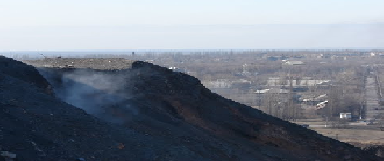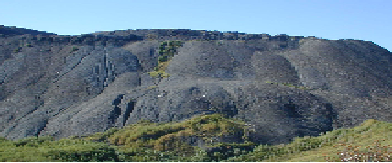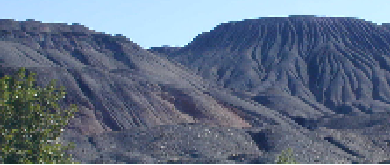

Mining regions is a zone of ecological disaster, and the coal industry enterprises are classified as environmentally hazardous. According to the state Statistics committee of Ukraine, in the coal-mining regions of Ukraine acts 258 coal mines, 10 cuts, giving on-the mountain for every 1000 tons of coal from 150 up to 800 tonnes of waste heaps, which cover huge areas, leading to intense defeat of air and chemical poisoning of surface water and groundwater, as well as significantly altering the hydrodynamic regime and the level of underground waters. Development of coal deposits negatively affects the hydrochemical characteristics of the operation of surface and underground water, the pollution of air space, impairs the fertility of the land.
 |
The total area of land allocated under the industrial site the coal–mining and enterprises, is about 22.5 thousand ha. According to the program "Energy strategy of Ukraine for the period up to 2030", at carrying out of mountain works of the coal mines annually, according to different estimates, is from 750 mln cu m to 2.7 billion m³ of methane, the absolute majority of which absorb the atmosphere.
Among the fugitive emission sources, a special place is also dumps of rocks, which may ignite. The volume of mine and career waters, coal mining, extraction of almost 600 million meters per year, whereas for domestic and industrial needs of the industry and for other consumers is used only 250 million meters (40%). In view of the extremely poor cleaning of mine waters in the rivers annually dissolves more than 1 million tons of mineral salts.
It is estimated that in order to prevent negative consequences of activities of mines in Ukraine to annually carry out environmental work to the amount of 230-240 million uah.
Such dumps and waste heaps occupy a huge area. Rock dumps and dumps contain up to 2.5% of sulfur and from 3 to 20% of coal, due to what they ignite spontaneously and burn to 7-12 years of intensive poisoning the ground layer of air surrounding territories products of combustion.
 |
In total in Donetsk coal basin there are 1185 operating and "end" dumps and dumps, of which about 400 burn and annually emit more than 500 thousand tons of harmful gaseous substances, and rain water, getting on these dumps, dissolve a significant amount of hazardous chemical elements and saturate their groundwater. Annually from 1 hectare average in terms of burnt waste heap blown out of more than 35 tons of soil and washed away a large mass of water-soluble salts. Products of wind erosion influence on the environment at a distance up to 100 km from the source of pollution. The zone of contamination by water erosion less, but, getting into the ground, reservoir and source of water supply, they "steal" the already scarce water resources of the region. Thus, besides the pollution of air, waste heaps and dumps due to drainage through them rain and melt water intensively contaminate surface water and groundwater with toxic elements coal and host of his breed [1].
Industrial dust – a principal view of pollution of atmosphere that global harm does: badly passes ultra-violet radiation, interferes with atmosphere self-cleaning, litters mucous membranes of respiratory bodies of the person and an eye, irritates a skin, is a carrier of bacteria and viruses, causes a cancer [2] in spite of the fact that in Donetsk, Dnepropetrovsk, Zaporozhye, Lugansk and Kharkov areas with concentration less than third of enterprises of the country which throw out a waste in atmosphere, receipt of dangerous substances in atmosphere in these regions made 80,8 % in 2006 from their total volumes about the country.
Coal mining is by all means accompanied by pumping out of mine and career waters, delivery on a surface of dead rocks, emissions of a dust and harmful gases, and also deformation breeds and a terrestrial surface and by that leads to pollution of water resources, atmosphere and soils, essentially changes hydro-geological, engineering-geological, atmospheric and soil conditions in zones of underground mountain workings out, depressive funnels by the area from tens to hundreds square kilometers and sometimes are formed and completely the rivers and streams disappear, the earned additionally territories are flooded or become boggy, the soil layer is dehydrated and salted that the big damage, in turn, causes to water and ground resources, air structure worsens, the shape of a surface of the earth changes.
For prevention of pollution of surrounding environment it is necessary to take as much as possible from breeds sulfur, coal and rare-earth elements, to use breeds for manufacturing of a brick and other building materials, and also for a bookmark of the fulfilled space of mines, especially in zones of an arrangement of settlements and the enterprises.
From all harmful influences of the coal industry on environment emissions of polluting substances in the atmosphere which volume exceeds 20 % from total amount of emissions in Ukraine are most extended and dangerous. Thus, through treatment facilities passes less than half of all. The most polluted atmosphere in Donetsk, Makeyevka, Alchevsk, Yenakiyeve, Lisichansk and Gorlovka. The main sources of atmospheric pollution coal industry should be called, first of all, methane emissions mine ventilation installations (5.6 billion m3 per year), as well as the products of combustion due to lower coal-bearing rocks in the dumps and waste dumps. The area of "dump" land is more than 7 thousand hectares, and slag-heaps - 4 thousand hectares. At present it is here "archived" of up to 1.3 billion tons of rocks, and annually is added 60 million t, rational use of them in the last years makes about 17% of the annual volume of the issue to the surface, including for developed space in the mines - only 9%. This testifies to the prevalence in the mines of the collapse of rocks in the mined-out space, which determines the intense subsidence of the earth's surface (annually on the area up to 1000 km²); exceeding the five-meter level is accompanied by flooding, water logging, trees and the emergence of the marshes. Due to the sagging flooding Donetsk makes up 31% of the area [1].
Recycling and use of waste material breed – one of the directions of the harmful effects of heaps on the environment and restoration of landscapes. Apart from the known ways to use rocks to produce fertilizers, as well as leaving her in the mined-out space, the new direction of recycling is still not enough developed. In dumps of coal mines lot of stocks of some metals, comparable by volume with a natural mineral deposits, the receipt of which is for Ukraine will be economically profitable, especially that at the present time many of the mineral resources have already been exhausted, that is one of the global problems. In the near future all the stocks of precious and non-ferrous metals, iron will be exhausted. Therefore, it is important to consider the waste of mining production, as an alternative variant of the natural resources [2].
The purpose of master's work is to develop technological solutions for the complex use of mining rocks in the conditions of OP SH/U "Trydovskoe" due to the decrease of harmful influence on the environment.
Object of research – OP SH/U "Trydovskoe"
Subject of research – waste dumps OP SH/U "Trydovskoe"
OP SH/U "Trydovskoe" with 01.08.2003 is included as a separate subdivision of the SE "he managed the company" and on administrative distribution refers to the Petrovsky district of the city of Donetsk. Profile of company activity - underground coal mining. OP SH/U «Trydovskoe» produces and sells coal of the grade D and DG. The basic consumers of coal are thermal power stations and industrial boiler houses, as well as the fuel is used for household needs of the population.
Table 1 – Actual coal production enterprise
|
Based on the analysis of statements of the company it is possible to draw a conclusion, that for the last years volumes of coal production are reduced and there is a failure to plan.
The enterprise on a coal mining belongs to the second class of danger to the sanitary – protective zone – 500 meters.
In the course of economic activity OP SH/U "Trydovskoe" has a negative influence on the environment: occupation of land for waste dumps; violation of the natural landscape of the earth's surface; the contamination of the atmosphere of solid and gaseous impurities; discharges of polluting substances in water objects, etc.
At the enterprise found 33 stationary sources of emissions of polluting substances in an atmosphere, 14 of which are organised, and 19 unorganized. The main sources of atmospheric air pollution by gases, fly ash and dust are boiler houses, waste rocks, drying facilities and warehouses of the coal. The combustion of a fuel and coal is accompanied by release of nitrogen oxides, carbon monoxide, hydrocarbons and sulfur dioxide gas. In the structure of harmful emissions is carbon dioxide (10150,574 t/year), carbon monoxide (507,84 t/year), sulfur dioxide (230,052 t/year), inorganic dust (99,58 t/year) [6].
Discharged mine water on the stiffness and a number of other components do not exceed the values similar components of the waters of the River Osykove and may not have a significant impact on the qualitative composition of water in the river. Some impact on the qualitative composition of water can have underground waters, coming directly into the River Osykove
The annual gross volume of industrial waste formation on mine is 504000 tons. However, the majority of waste are represented substances not dangerous (IV class of hazard). The volume of waste of the III and II risk is insignificant – 25,5 tons/year or 0.005% of the annual volume of all types of waste mine, as a result of which (taking into account production capacity of the enterprise), it can be assumed that the above-mentioned waste do not render significant influence.
According to the statements of mine, the main part of the species (90%) comes in to the blade of the concentrator. The rest of the breed comes from not dangerous barrel. In the mouldboard mass includes: brown coals, stone, anthracite, coke, oil shale, peat.
On the balance sheet sh/u is six non-performing rock dumps is not working mines № 7 and "Schurovka".
 |
 |
The current breed blade is a complex consisting of 3–cone and a flat blade with a common base. Dump located in the western part of the industrial area of the mine and operated since 1952.According to the method of execution breed Blade is an open surface, bulk type. The annual supply of rock in Blade - 87 meters. Since the temperature of rocks in the outbreak is over 80° C, according to DNAOP 1.1.30-5.37-96, «Instructions for the Prevention of spontaneous combustion, fire, and the development of waste dumps," this blade is burning, which greatly increases its negative impact on the environment.
Has a negative impact on the environment, the budget pays for sh/u pollution charges, incurs additional costs. Dynamics of the fee for the pollution of the environment is presented in Figure 5.
From Fig. 5, we can conclude that in recent years the amount of pollution has decreased significantly. This is due to the fact that decreased amounts of coal in the mine. Thus, reducing the negative impact of industrial activity on the environment is one of the major challenges of environmental and economic activities of the mine. Measures should be taken to reduce loss-making mines. There are many ways for solving this problem, but given the large number of species, we can conclude long-term planning of technological solutions. Consider it important to implement processing equipment for the breed, as well as manufacturing of its building materials for resale. Objectives: 1. Analysis of the status of research on integrated use of the breed. 2. Rationale for directions to improve the efficiency of management of blast rock for used inside needs, and for national economic goals. 3. Perform feasibility study made use of technological solutions for rock for construction purposes. We consider technological solutions to the sound of rock as a resource in an enterprise environment. Proved that one of the main directions to reduce the harmful effects of pollution sources in the environment is the use of rocks for the manufacture of building materials. TopicalityBurnt rocks – product self-firing waste rock. Their chemical and mineralogical composition determined by the nature of the coal–bearing formation pool. If the combustion takes place in the bowels of the earth by underground fires, the resulting steady erosion of this formation formed by natural burnt rocks. Oxidative self-firing mine rocks, which contain up to 30% coal, obtained dumped burnt rocks with a dense layered structure. Actually burnt rocks called burnt empty mine rocks containing a minimal (less than 5%) amount of carbonaceous impurities and mineral clay-sand part, burned to varying degrees. These include all varieties of natural burnt clay-sand mixtures with different amounts of carbonaceous impurities, sometimes incompletely burned. Dump burned rocks (from the waste heaps of mines) are the most abundant and cheap raw materials. However, these rocks have a high content of unburned coal, and require careful selection and enrichment. Old and completely burned mine waste piles often contain burnt rocks of high quality [3]. Burned rocks can be regarded as a natural part of cement, the nature of the stock in huge quantities. Finely ground and mixed with lime and other activator, they are a kind of besklinkernym astringent [4]. In addition to materials for industrial land and housing, burnt rocks are valuable raw material for production of these special components – bentonite, which serve to secure the underground mine workings. The most important technical properties of burned rocks – their chemical properties, high durability with respect to various aggressive factors – allows use construction materials from burned rocks where concrete, wood and metal is less durable (eg ,mounting shafts in permanent and long-term effects of aggressive treatment). Building materials from a mixture of burned rocks with lime, reinforced with metal, not afraid to corrosion, because this mixture has an alkaline nature. When the autoclave processing of high-burned rocks can produce products with high mechanical strength [5]. Also recently become widely used in mine rock for the manufacture of construction materials such as paving slabs and bricks. Economic benefits integrated use of industrial wastes is due primarily saving capital investments and lower production costs in industries that produce construction materials, and in industries that have a salvage raw materials.
|